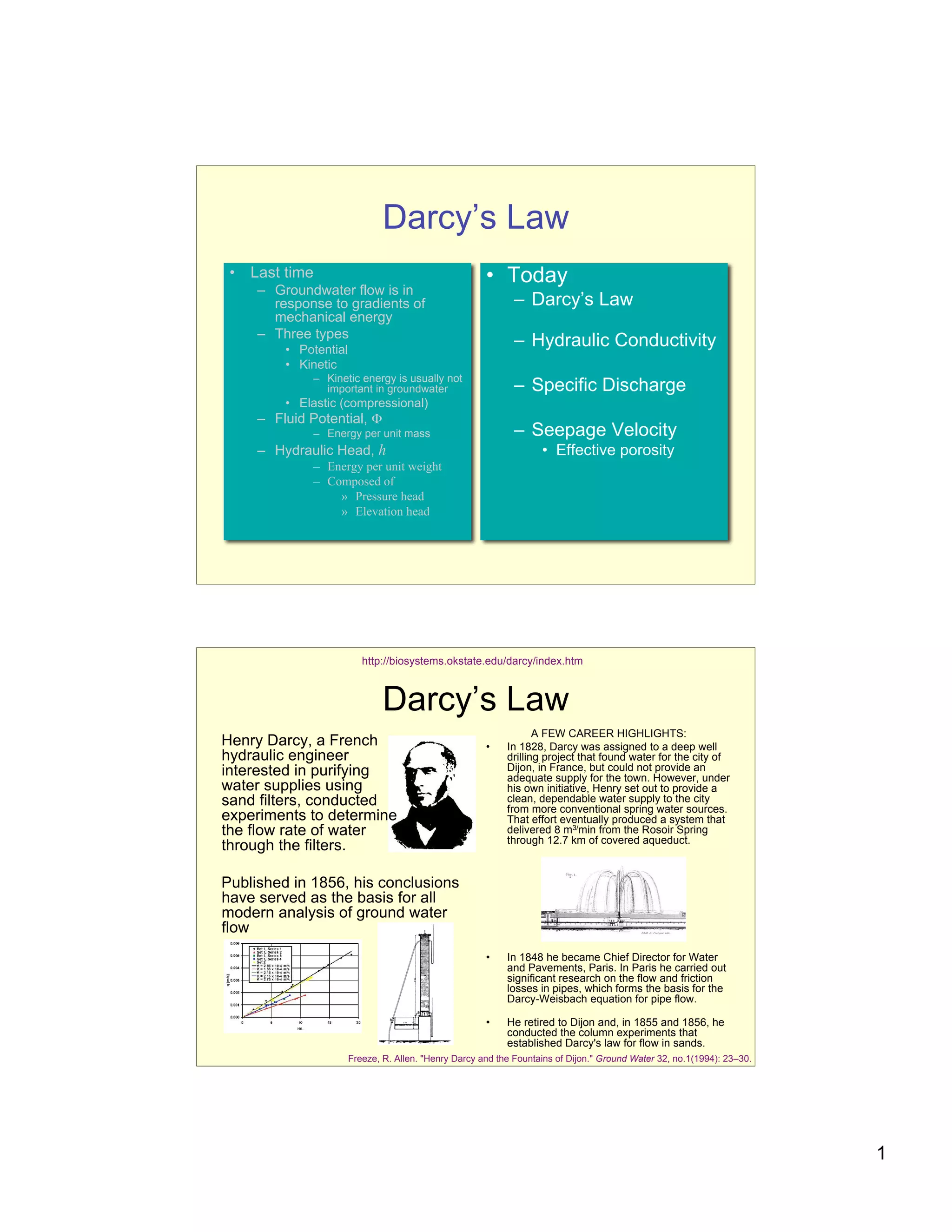Darcy's law describes groundwater flow and states that the discharge of water through a porous medium is proportional to the hydraulic gradient. Specifically, discharge is equal to the hydraulic conductivity multiplied by the cross-sectional area available for flow multiplied by the hydraulic gradient. Darcy found that discharge is directly proportional to cross-sectional area and hydraulic gradient, and inversely proportional to flow path length. His experiments established the foundation for analyzing groundwater flow and led to the concept of hydraulic conductivity.

![Darcy’s Law
Cartoon of a Darcy experiment:
Sand-filled column
Constant head tanks with bulk cross-sectional area A
at each end
#
Q - Rate of
"l discharge [L3/T]
dh
h1
#
h2
Datum
In this experiment,
water moves due to gravity.
What is the relationship between
discharge (flux) Q and
other variables?
A plot of Darcy’s actual data:
http://biosystems.okstate.edu/darcy/index.htm
2](https://image.slidesharecdn.com/l2darcyslaw-100720145852-phpapp01/75/L2-darcys-law-2-2048.jpg)
![What is the relationship between
discharge (flux) Q and
other variables?
Darcy found that:
1) If he doubled the head difference (dh = h2 – h1),
then the discharge Q doubled.
2) If he doubled column length (dl),
Q halved
3) If he doubled column area (A),
Q doubled. Sand-filled column
Constant head tanks with cross-sectional area A
at each end
#
Conclusions: "l
Q - Rate of
discharge [L3/T]
Q is proportional to dh "h
h1
Q is proportional to 1/dl #
h2
Q is proportional to A Datum
Darcy’s Law
Darcy also found that if he used different kinds
of sands in the column, discharge Q changed,
but for a particular sand, regardless of Q:
Q dl
= a constant
A dh
This “proportionality constant” is usually called
“hydraulic conductivity” and often is assigned the
symbol, K. Leads to Darcy’s Law:
dh
Q = ! KA =conductivity x bulk area x ‘gradient’
dl
3](https://image.slidesharecdn.com/l2darcyslaw-100720145852-phpapp01/75/L2-darcys-law-3-2048.jpg)



![Hydraulic Head
• In Darcy’s experiment, do the drops falling from the
constant head tanks have constant velocity?
Sand-filled column
Constant head tanks with cross-sectional area A
at each end
#
Q - Rate of
"l discharge [L3/T]
"h
h1
#
h2
Datum
Hydraulic Head
• In Darcy’s experiment, do the drops falling from the
constant head tanks have constant velocity?
• No! Water droplets accelerate at 9.8 m/s2.
• Assuming no air resistance, the falling water drop has its
potential energy converted to kinetic energy as it falls:
1 2
mgz + mv = total energy = constant,
2
that is, its a conservative energy field.
But water through our column has constant velocity—why?
7](https://image.slidesharecdn.com/l2darcyslaw-100720145852-phpapp01/75/L2-darcys-law-7-2048.jpg)



![Flow in the vicinity of a sphere
y
U R
• Inertial force per unit "u !u 3
x
volume at any location: !x " = density [M/L ]
u = local fluid velocity [L/T]
Rate of change of momentum
U = mean approach velocity [L/T]
• Viscous force per ! 2u µ = fluid dynamic viscosity [M/LT]
µ 2 ! = fluid kinematic viscosity [L2 /T]
unit volume: !y x, y = Cartesian coordinates [L],
x in the direction of free
stream velocity,U
inertial forces
• Dynamic similarity: Re =
viscous forces
"u (!u !x )
Re = = constant for similitude
µ (! 2 u !y 2 ) Don’t worry about where the
expressions for forces come from.
H503 students, see Furbish, p. 126
Flow in the vicinity of a sphere
y
Using a dimensional U R
x
analysis approach,
" = density [M/L3 ]
assume that u = local fluid velocity [L/T]
U = mean approach velocity [L/T]
functions vary with characteristic µ = fluid dynamic viscosity [M/LT]
quantities U and R, thus ! = fluid kinematic viscosity [L2 /T]
x, y = Cartesian coordinates [L],
u !U x in the direction of free
"u U stream velocity,U
!
"x R
" 2u U
!
"y 2 R 2
11](https://image.slidesharecdn.com/l2darcyslaw-100720145852-phpapp01/75/L2-darcys-law-11-2048.jpg)






